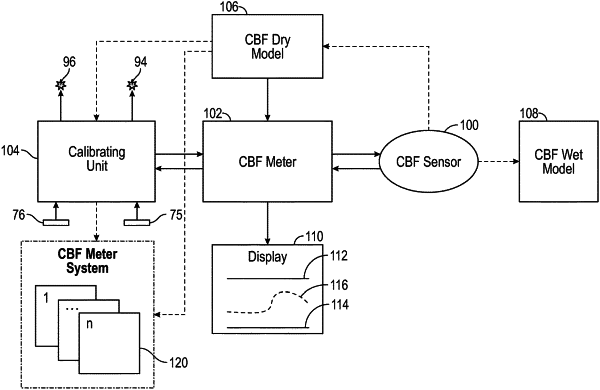| CPC A61B 5/026 (2013.01) [A61B 2560/0223 (2013.01); A61B 2560/0242 (2013.01)] | 26 Claims |

|
1. A method for calibrating a capillary blood flow sensor in absolute flow units, the method comprising:
providing a capillary blood flow sensor comprising a heater for changing the temperature of an area of a surface from a first temperature to a second temperature and for maintaining a constant temperature gradient between the first and second temperatures, a power source for providing a power to the heater, and a temperature sensor for measuring temperature at the area of the surface;
providing a wet model device comprising a flow path for a flowing fluid which is maintained at physiological temperature, one portion of which is covered by a barrier material having a top surface and a bottom surface and in contact with the flowing fluid on the bottom surface, and having a sufficient area for the heater and the temperature sensor to simultaneously contact the top surface of the barrier material;
initiating a preselected first fluid flow along the flow path and determining a corresponding first heater power dissipation in order to maintain the temperature gradient constant, and initiating a preselected second fluid flow along the flow path and determining a corresponding second heater power dissipation in order to maintain the temperature gradient constant;
providing a dry model device comprising a first site on a first heat sink and a second site on a second heat sink and translating the first heater power dissipation and the second heater power dissipation of the wet model device to the thermal conductivity parameters at the first site and at the second site by adjusting the thermal conductivity at the first site when the heater is operated at a first heater power determined using the wet model device, to maintain the temperature gradient constant, and adjusting the thermal conductivity at the second site when the heater is operated at a second heater power determined using the wet model device, to maintain the temperature gradient constant in an adjusted dry model device; and
calibrating a capillary blood flow sensor in absolute flow units using the adjusted dry model device by assigning the first heater power to correspond to the preselected first fluid flow and assigning the second heater power to correspond to the preselected second fluid flow.
|